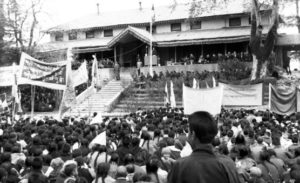(TibetanReview.net, Nov13’19)
When over 80,000 Tibetans fled Chinese occupation and followed His Holiness (HH) the Dalai Lama to India in 1959, none of them had any premonition of the duration of their stay in India. They endured the hardships in exile with a strong aspiration to return to Tibet soon.
Nation building became the primary task of the Tibetans under the leadership of HH the Dalai Lama. This process of nation building began with the establishment of governmental infrastructure in the form of Tibetan Government in exile in 1960.[i] The Tibetan leadership with support from the government of India and various other governmental and non-governmental agencies had the challenging task of chalking out a rehabilitation plan and simultaneously advocating for restoration of freedom in Tibet.
Central Tibetan Administration
The seat of the exile government was set up in Dharamshala in 1960. While the Executive and the Legislative branch of the government was set up in 1960, the Judiciary came into operation through a provision under the Charter of Tibetans in exile in 1992.[ii]
The State governments of Karnataka, Orissa, Himachal Pradesh, Madhya Pradesh, and Uttar Pradesh as well as Sikkim[iii] were approached via the Government of India for permanent settlement of arriving Tibetans. Most of the settlements in India were built on government land that was made available for a period of 99 years. While the bulk of Tibetans were resettled in India, several Tibetan settlements came into existence in Nepal and Bhutan. Tibetans resettled in 46 settlements all over India, Nepal and Bhutan are managed by the Department of Home, CTA through the various Settlement and Welfare Offices.

Education was given a priority right from day one of being in exile. With strong support from the Indian government and other humanitarian agencies, schools were set up where young Tibetans were given modern education with parallel focus on sustaining Tibetan language and culture. The Department of Education, CTA currently oversees 73 schools in India and Nepal.
To reinforce the national identity of Tibetans in exile, Basic Education Policy was formulated and adopted in the Parliament in 2001. Under the Basic Education Policy, Tibetan became the only medium of instruction in Tibetan schools with English as a second language introduced in Grade IV and a third language in Grade VI.
Despite many hurdles in the implementation of the basic education policy, today most Tibetan schools have managed to adopt the policy fully at the primary level and the effort is on to pursue it beyond that.
Advocacy for Tibet led to the passing of three United Nations General Assembly resolutions on Tibet. While the 1959 and 1965 UNGA Resolutions calls for respect for the fundamental human rights of the Tibetan people and for their distinctive cultural and religious life, the 1961 resolution recognises the right of self-determination of the Tibetan people. Since then, global polity has gradually shifted in favour of China beginning with Taiwan losing its UN seat to China in 1971. China is a global power today with dominance in economy and trade. Despite the growing influence of China, Tibetan leadership relentlessly campaigned for Tibet. Numerous resolutions have been passed and statements made in the US Congress, EU Parliament and Parliaments of many countries including Australia, Canada, France, Italy, Germany and Japan.
A middle way approach (MWA) which was simmering since 1974 in the Tibetan domain was publicly declared by HH the Dalai Lama in Strasbourg in 1988 as a mutually beneficial and pragmatic solution with the vision to sustain Tibetan identity, culture and the struggle for freedom[iv]. With no major breakthrough in the Sino-Tibetan dialogue, HH the Dalai Lama proposed a Referendum on the future course of the Tibetan struggle in his 10th March Addresses of 1996 and 1997. In a preliminary poll coordinated by Kashag (Cabinet) and Assembly of Tibetan People’s Deputies (ATPD) now known as Tibetan Parliament in Exile (TPIE), 64 percent of the participants opinionated against referendum and supported the middle way approach. In accordance with this opinion poll, a unanimous resolution in support of the middle way approach was passed by the ATPD in 1997. MWA has formed the basis of renewed Sino-Tibetan dialogue between 2002-2010 between Envoys of HH the Dalai Lama and Chinese government. Since then, the communication has reached a deadlock because of unacceptable pre conditions from China. Efforts are ongoing to renew Sino-Tibetan dialogue.
In addition to lobbying the governments, UN and other international organisations, Tibetans also began to appeal to masses through the Tibet support groups which were set up mainly in Europe and North America and gradually in few countries in South America and Asia. International Campaign for Tibet initiated as a Tibet advocacy group in Washington DC in 1988 was instrumental in raising the profile of Tibet in the US.[v] The Tibet Policy Act 2002 passed by the US Congress to support the aspiration of the Tibetan people to safeguard their distinct identity and to encourage substantive dialogue between Beijing and representatives of HH the Dalai Lama is one such successful effort.[vi] Today most Tibet Support groups are under the umbrella of International Tibet Network, a global coalition established to strengthen the Tibetan movement.[vii]
Tibetan Green Book contribution plays a very important role in creating a sense of contribution and pan Tibetan identity. As a show of support to CTA from the Tibetans in exile, Bhod Rawang Denpei Legyul (Tibetan Freedom Movement) was set up on July 30, 1972 at a conference where a resolution was passed to make voluntary contribution. In 2005, this responsibility of collecting voluntary contribution was taken over by the Department of Finance, CTA. Tibetans living in the Indian Sub-continent between the age of 6-14 contribute 12 INR per year; 15-17 years of age contribute 48 INR and students and unemployed who are above 18 years of age donate 58 INR as voluntary contribution. All CTA employees contribute 4 percent of their basic pay which is deducted at source. The contribution for Tibetans outside India are as follow: 12 USD for ages 6-17, 46 USD for students and 96 USD for those with steady income. Approximately 1,40,000 Green books have been issued so far with current contribution including those from non governmental institutes amounting to about 150 million INR making it about 6 percent of the CTA revenue. The Green book is the only document which is a proof of being a bona fide Tibetan for the larger Tibetan diaspora.

Gradual effort to democratise the exile administration by HH the Dalai Lama led to many amendments to the Charter and finally transfer of political leadership to popularly elected Sikyong (President) in 2011. Currently under the Executive branch headed by Sikyong with his Council of Ministers, there are seven major Departments: Department of Information and International Relations; Department of Education; Department of Home; Department of Finance; Department of Religion; Department of Health and Department of Security.[viii]
To sustain the Tibetan movement, the current Kashag has drawn up five fifty vision for Tibet seeking to maximize efforts to resolve the Tibet issue in five years based on the Middle Way Approach while ensuring CTA’s resilience to sustain the Tibetan freedom struggle, promote Tibetan National identity and preserve Tibetan culture for the next fifty years if needed.[ix]
A Legislative body called ‘Commission of Tibetan People’s Deputies’ (CTPD) was set up with 13 elected representatives called ‘Deputies’. Tibetans in exile celebrate the oath taking day of the Deputies on 2nd September,1960 as Tibetan Democracy Day. Under the Tibetan Charter drafted and passed in 1991, CTPD became ATPD (Assembly of Tibetan People’s Deputies) to include 10 elected members each from the three Provinces of Tibet: Kham, Amdo and Utsang irrespective of their actual population size in exile. Two from Europe and one from North America was also included to represent the population there. Additionally, 2 members each from the four Buddhist religious sects: Kargyu, Gelug, Nyingma, Sakya and 2 from Bon (Pre Buddhist religion) were added. The Charter gave powers to HH the Dalai Lama to appoint upto three members of Parliament which he gave up after the end of the 13th House term. Today this legislative body is called Tibetan Parliament in exile and it has 45 elected members including two from Europe, two from North America and one from Australasia.[x] In the composition of the Parliament, Tibetan leadership prioritised a policy of unity-in-diversity to create an inter-dependence of the regional groups in their joint pursuit of an imagined Tibet.
As the highest legislative body, TPIE monitors and passes CTA budget, and drafts and/or sanctions all policies related to the workings of CTA. Since the 14th House of the Tibetan Parliament in Exile, Tibetan Parliament members are assigned constituencies in India and Nepal to connect directly with Tibetans once a year. TPIE advocates for freedom in Tibet through its lobbying efforts with other world Parliamentarians in various fora including the World Parliamentary Convention on Tibet (WPCT). The Seventh WPCT was held recently in Riga, Latvia, from May 7-10, 2019 where Parliamentarians from over 12 countries met, deliberated and adopted a declaration and action plan on Tibet.[xi]
Four most important elements of the Declaration are as follows:
- Reaffirms that Tibet has historically never been a part of China and rejects China’s historical claim over Tibet
- Recognises Middle Way approach as the most viable solution and seeks resumption of Dialogue between Envoys of HH the Dalai Lama and China without preconditions
- Urges countries to adopt Reciprocal Access to Tibet Act and Global Magnitsky Human Rights Accountability Act
- Expresses concern at the PRC government’s harassment of Tibetans living in exile and its instigation of disharmony within Tibetan communities in exile
The Role of Tibetan Civil Society
A parallel role of nation building is played by the Tibetan NGOs engaged in the Tibetan freedom movement. Tibetan Youth Congress (TYC) and Tibetan Women’s Association (TWA) are the oldest and largest Tibetan NGOs in exile. TYC was set up in 1970 with the objective of working towards political independence of Tibet. In advocating for independence, TYC has made it amply clear that their stand is in response to the Chinese brutality and oppression and not in opposition to the middle way approach as envisioned by HH the Dalai Lama and adopted by the Central Tibetan administration.[xii]
TWA was reinstated in 1984 as a continuation of the Tibetan Women’s Uprising on March 12, 1959 with the primary objective of creating awareness on the situation of Tibetan women inside Tibet and social empowerment of women in exile. TWA’s advocacy efforts gained prominence with the UN Beijing Women’s Conference in 1995.[xiii]
Both TYC and TWA are Tibet advocacy groups with presence in all the settlements in India and in few countries abroad. In addition, there are regional associations representing the three regions of Kham, Amdo and Utsang in Tibet.
Gu Chu Sum was founded on 27th September 1991 as a Tibetan freedom movement led by Ex Political Prisoners to protests against Chinese oppression in Tibet and for the welfare of Ex Political Prisoners and their family members.[xiv]
Students for Free Tibet is an international network founded in 1994 with the understanding of the significant role played by students and younger generation in freedom struggles all over the world[xv]
Tibetan Center for Human Rights and Democracy is a non profit human rights advocacy organisation set up in 1996 with the mission to monitor human rights situation in Tibet and to promote democracy in exile. [xvi]
An important organisation in awakening a pan Tibetan identity in the early phase of Chinese occupation of Tibet was the establishment of Chushi Gangdrug (Four Rivers and Six Ranges) Tensung Danglang Mak (National Volunteer Defence Army) on 16 June, 1958. Although it was spearheaded by Andrug Gompo Tashi, a successful businessman from Lithang, Kham, it was soon embraced by the whole Tibetan nation as the resistance movement during the early phase of Chinese occupation.
The CIA influenced by Cold War politics began to covertly support Chushi Gangdrug from early 1959 with material assistance and aid including arms and ammunitions. The group successfully escorted HH the Dalai Lama during his escape to India and surrendered their weapons to the Indian authorities at the border. However, Chushi Gangdrug carried out its guerilla operations from 1960-1974 from their base in Mustang, Nepal with covert support from CIA. This guerilla operation ended with the cessation of CIA assistance following renewed friendship between China and the United States in 1974 under President Nixon.
Around the same time, another important Tibetan Paramilitary Force was being set up by the Government of India monitored by the Intelligence Bureau (IB) and later by the Research and Analysis Wing (RAW). The establishment of a Special Frontier Force (SFF) on 14 November 1964 known among Tibetans as HQ 22 was a direct response to the 1962 Sino-India War. India understood the need for a special frontier force to defend its borders in remote Himalayan regions. The nominated head of the establishment was called Dapon (Tibetan equivalent of a Brigadier). He along with his group of Political Leaders administered SFF. While India saw the establishment of 22 as a force to defend its borders, Tibetan Political Leaders saw it as a unifying force to fight for Tibet.
Over the past two decades, Tibetan Community Associations abroad have increasingly assumed an important role in promoting a Pan Tibetan identity. While early Tibetan immigration was to Switzerland and Canada followed by immigration of 1000 Tibetans to the US in 1990, Tibetans today are scattered in many countries in North America, Europe and Australasia. In these countries, Tibetans are not only working hard to sustain their language and culture but also lobbying their politicians to support the cause of Tibet. Some of these Associations have even managed to build Tibetan Community Centres to gather not only for political and social events but also to hold Tibetan language and culture classes for young Tibetans.
Although there is a trend of migration to the West among young Tibetans, at the same time we are also witnessing an increase in the number of Tibetans coming back to India to serve the community in various capacities particularly under Tibet Corp initiated by CTA to promote a spirit of engagement and contribution among young Tibetans both in India and abroad.[xvii]
Central Tibetan Administration, Tibetan NGOs and Tibetan Community Associations all share a common aspiration to sustain the Tibetan identity and movement.
* Ms Youdon Aukatsang is a member of the Tibetan Parliament in Exile
————————————
[i] Officially known as the Central Tibetan Administration
[ii] This charter governs the working of all the branches of CTA. To read the full document: https://tibet.net//wp-content/uploads/2014/07/Charter.pdf
[iii] Sikkim was then a Protectorate of India.
[iv] For the Strasbourg Proposal, visit https://www.dalailama.com/messages/tibet/strasbourg-proposal-1988
[v] visit www.savetibet.org for more information on ICT
[vi] To read the full document, visit https://2001-2009.state.gov/p/eap/rls/rpt/20699.htm
[vii] For more on ITSN: https://tibetnetwork.org/about-us/
[viii] Visit www.tibet.net for detailed background on Central Tibetan Administration
[ix] For details on CTA’s five fifty vision with regard to building resilience for 50 years if need be: https://sardfund.org/wp-content/uploads/Five-Fifty_BackgroundPaper-Complete-3SEPT18.pdf
[x] Check www.tibetanparliament.org for background on Tibetan parliament and current workings
[xi] For details: https://tibet.net/2019/05/the-riga-declaration-7th-world-parliamentary-convention-on-tibet/
[xii] To learn more about TYC work, visit their website https://www.tibetanyouthcongress.org/
[xiii] To read more on Tibetan women’s participation at the Beijing Conference, read https://tibetanwomen.org/tibetan-women-world-conference-on-women-beijing-1995/
[xiv] To know more about Gu Chu Sum, visit https://www.guchusum.in/
[xv] For more on SFT: https://studentsforafreetibet.org/
[xvi] To know more about TCHRD, visit http://tchrd.org/about-us/
[xvii]To read more on Tibet Corps: https://tibetcorps.org/
References
CTRC (2003) His Holiness the Dalai Lama’s Central Tibetan Relief Committee: Building Sustainable Communities in Exile, Dharamshala: Central Tibetan Relief Committee
Department of Education (2005) Basic Education Policy for Tibetans in Exile, Dharamshala: Department of Education, CTA
Department of Information and International Relations (2018) Tibet was Never a Part of China: The Middle Way Approach Remains a Viable Solution, Dharamshala: DIIR, CTA
Department of Information and International Relations (2005) International Resolutions and Recognition on Tibet (1959-2004), Dharamshala: DIIR, CTA
Dorjee, Tenzin (2016) The Tibetan Nonviolent Struggle: A Strategic and Historical Analysis, Boston: ICNC Monograph Series
Information Office of His Holiness the Dalai Lama (1981) Tibetans in Exile 1959-1980, Dharamshala: CTA
Jamyang Norbu (1994) The Tibetan Resistance Movement and the Role of the CIA in Robbie Barnett, Resistance and Reform in Tibet, London: Hurst pp 186-96
Knaus, John Kenneth (1999) Orphans of the Cold War: America and the Tibetan Struggle for Survival, New York: Public Affairs
Kauffman, Thomas (2018) The Agendas of Tibetan Refugees: Survival Strategies of a Government-in-Exile in a World of International Organisations, New York and Oxford: Berghahn
McConnell, Fiona (2016) Rehearsing the State: The Political Practices of the Tibetan Government-in-Exile, Oxford: Wiley Blackwell
Roemer, Stephanie (2008) Tibetan Government-in-Exile: Politics at Large, London and New York: Routledge
Shakya, Tsering (1999) The Dragon in the Land of Snows: A History of Modern Tibet Since 1947, London: Pimlico
Tsering, Lhasang (1990) Twenty Years of Tibetan Youth Congress- For Rangzen Now and Always, Tibetan Youth Congress: 20 Years 1970-1990, Dharamshala: Tibetan Youth Congress
—







